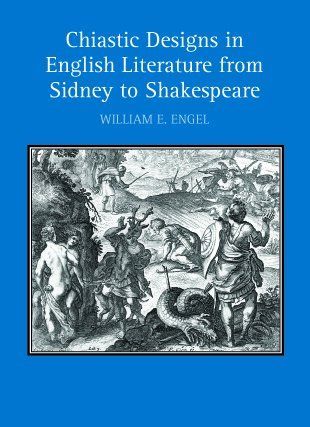CHIASTIC DESIGNS
IN ENGLISH LITERATURE
FROM SIDNEY TO SHAKESPEARE
FROM SIDNEY TO SHAKESPEARE
REVIEWS:
"...ein erster Exkurs auf einem riesigen neuen Feld [...a first ever exploration of an enormous new field]"
--Shakespeare Jahrbuch (2012)
--Shakespeare Jahrbuch (2012)
"Engel is a great champion of the ars memorativa
as the key to Renaissance culture...[bringing] his formidable erudition to bear on a strictly literary and iconographic analysis of a wide range of texts. His appreciation of the craftedness of poems, plays, and romances, and his sensitivity to their acoustic dimension speak to his sense that literary art offers a kind of salvation in the face of disorder and meaninglessness."
--Sixteenth Century Journal
42:2 (Summer 2011)
"Engel achieves what he set out to accomplish in Chiastic Designs. He provides a robust and dynamic definition of chiastic design and lays out a range of diverse rhetorical situations where it is deployed in relation to different conceptions of memory work. [...] Engel is offering a valuable reconsideration of the scale of rhetorical tropes as well as the implications of his extension on the possibilities for evoking a memorial ethos within renaissance literature."
--Rhetorica 30.4 (Autumn 2012)
--Rhetorica 30.4 (Autumn 2012)
"Engel creates nuanced interpretations because his chiastic designs are inclusive and adaptable. [...] Engel offers readers exceptional sensitivity to the patterns of literature through ingenious discoveries with fertile analyses of constituting evidence. --Renaissance Quarterly
63:1 (Spring 2010)
Buy this book
"William Engel has launched a provocatively suggestive approach that is also loaded with implication for exploring how literature from Sidney to Shakespeare may ˜suit the action to the word, the word to the action'." --Review of English Studies
61:249 (April 2010)
"Particularly interesting is Engel's notion that such structures work as a 'resonant memory chamber' that creates both depth and continuity of meaning." --Studies in English Literature
50:2 (Spring 2010)
"Engel's critical vocabulary comes from Cassirer and Panofsky, and his aesthetic categories from Virgil, Ovid, and Aristotle...he carries it off with great erudition, lucidity, and commitment to his texts as wrought, purposive, and susceptible of exegesis." --Spenser Review
41:1 (2011)
JACKET ENDORSEMENTS:
"William Engel's work is always learned, instructive, and adventuresome and Chiastic Designs is no exception. Engel uses his knowledge of biblical and classical authors and rhetorical writers of the Renaissance to reveal their reliance on chiasmus--the rhetorical figure of ABC:CBA, a double movement forward and backward--which results in patterned words and ideas including mirroring and echoic effects as well as ring structure and triadic designs. These principles of organization lead to a fresh understanding of how the works of Sidney, Spenser, Shakespeare, and Quarles might have been constructed." --Arthur F. Kinney, Director of the Massachusetts Center for Renaissance Studies, UMASS
"Building on his two richly suggestive previous studies, Professor Engel examines the chiastic patterning that was part and parcel of early modern mnemonic culture. In the process he considerably enhances our understanding not only of a wide variety of texts, but also of the philosophy itself of symbolic form." --Michael J. B. Allen, Distinguished Professor of English and of Italian Renaissance Studies, UCLA
DESCRIPTION:
Paying special attention to Sidney's Arcadia, Spenser's Faerie Queene, and Shakespeare's romances, this study engages in sustained examination of chiasmus in early modern English literature. The author's approach leads to the recovery of hidden designs which are shown to animate important works of literature; along the way Engel offers fresh and more comprehensive interpretations of seemingly shopworn conventions such as memento mori
conceits, echo poems, and the staging of deus ex machina. The study, grounded in the philosophy of symbolic forms (following Ernst Cassirer), will be a valuable resource for readers interested in intellectual history and symbol theory, classical mythology and Renaissance iconography. Chiastic Designs affords a glimpse into the transformative power of allegory during the English Renaissance by addressing patterns that were part and parcel of early modern "mnemonic culture."


